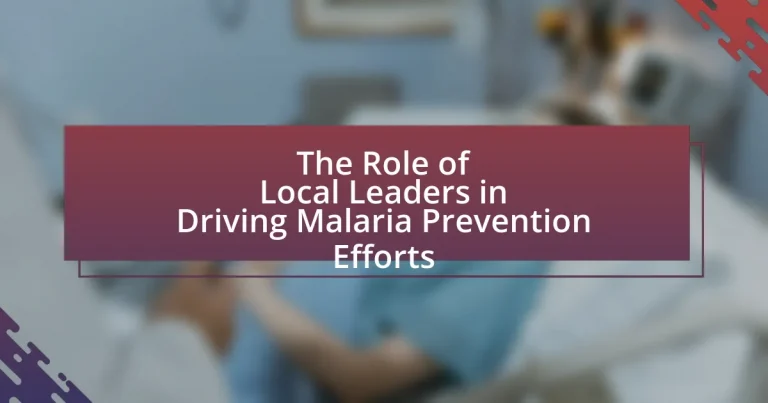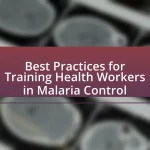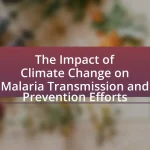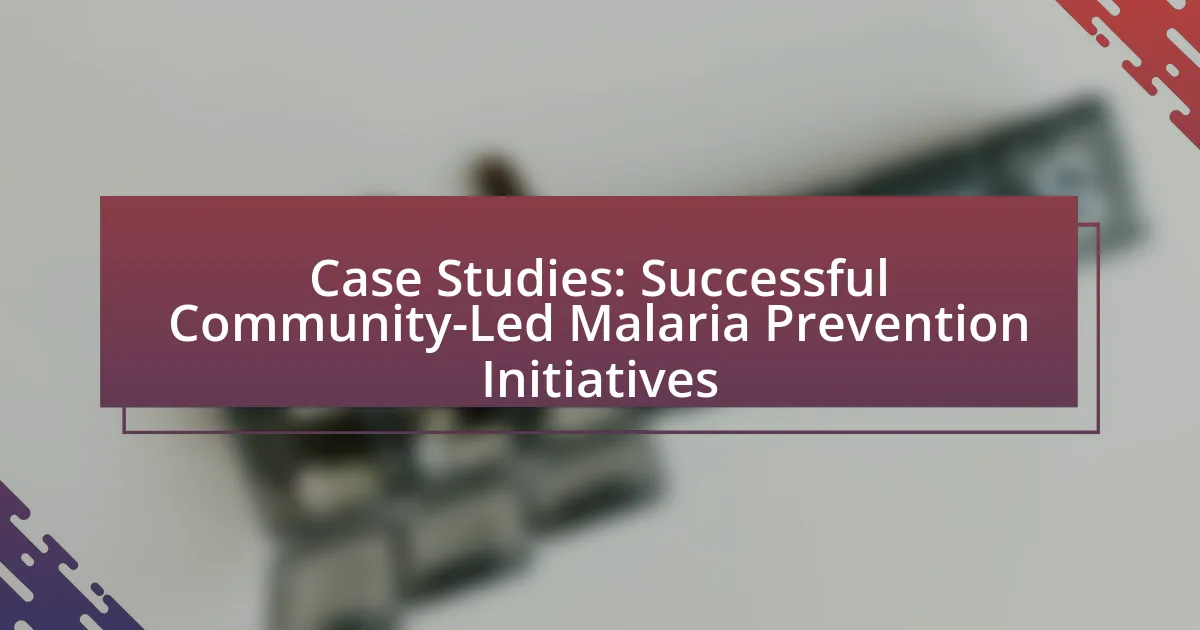Local leaders are pivotal in driving malaria prevention efforts within communities by mobilizing resources and fostering engagement. They effectively communicate the importance of preventive measures, such as insecticide-treated bed nets and indoor residual spraying, leading to increased participation in malaria control programs. The article explores how local leaders influence community engagement, utilize strategies to mobilize resources, foster collaboration among stakeholders, and address challenges they face in malaria prevention. Additionally, it highlights the impact of socio-economic factors, the role of partnerships, and practical steps local leaders can take to enhance malaria prevention initiatives, ultimately demonstrating their essential role in reducing malaria incidence.
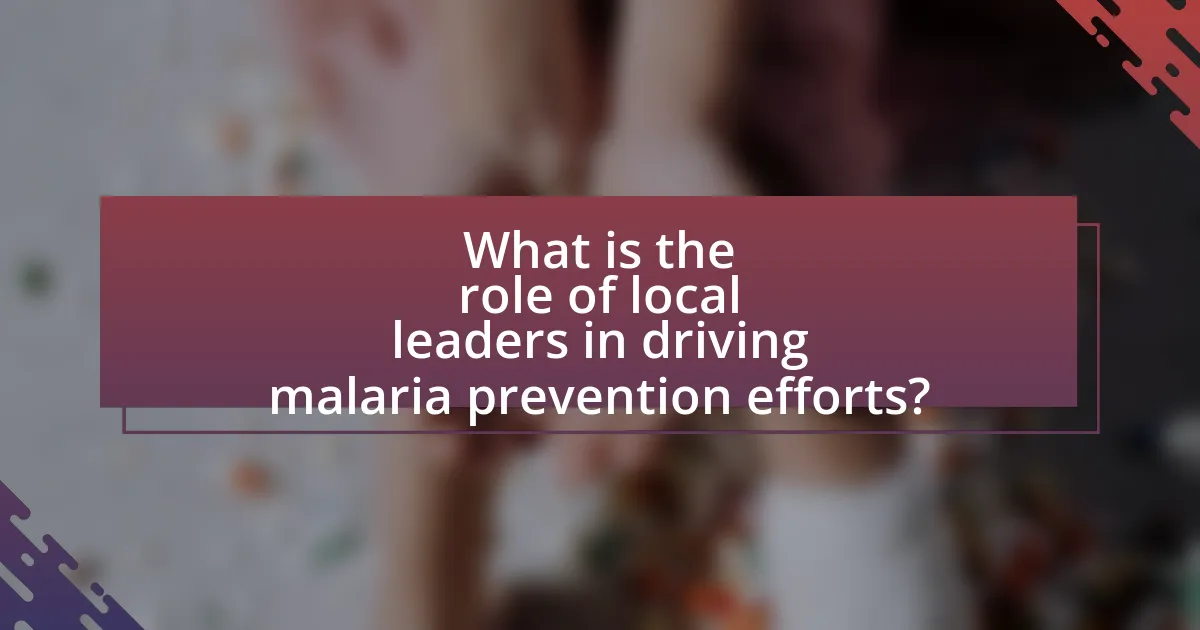
What is the role of local leaders in driving malaria prevention efforts?
Local leaders play a crucial role in driving malaria prevention efforts by mobilizing community resources and fostering local engagement. They serve as trusted figures who can effectively communicate the importance of malaria prevention measures, such as the use of insecticide-treated bed nets and indoor residual spraying. Research indicates that communities with active local leadership experience higher rates of participation in malaria control programs, leading to a significant reduction in malaria incidence. For instance, a study published in the American Journal of Tropical Medicine and Hygiene found that community-led initiatives, supported by local leaders, resulted in a 30% decrease in malaria cases in targeted areas. This demonstrates that local leaders are essential in not only advocating for preventive measures but also in ensuring their implementation and sustainability within the community.
How do local leaders influence community engagement in malaria prevention?
Local leaders significantly influence community engagement in malaria prevention by acting as trusted figures who mobilize resources and disseminate information. Their established relationships within the community enable them to effectively communicate the importance of malaria prevention measures, such as the use of insecticide-treated nets and indoor residual spraying. For instance, studies have shown that communities with active local leadership experience higher participation rates in malaria prevention programs, as leaders can tailor messages to resonate with local cultural practices and beliefs. Additionally, local leaders often facilitate partnerships with health organizations, enhancing access to preventive tools and educational resources, which further strengthens community involvement in combating malaria.
What strategies do local leaders use to mobilize community resources?
Local leaders mobilize community resources through strategies such as building partnerships, engaging in community education, and leveraging local networks. By forming alliances with health organizations and NGOs, local leaders can access additional funding and expertise, which enhances resource availability for malaria prevention initiatives. Community education efforts, including workshops and informational campaigns, raise awareness about malaria and encourage community participation, leading to increased volunteerism and resource contributions. Additionally, local leaders utilize existing social networks to disseminate information and gather support, effectively mobilizing community assets for malaria prevention. These strategies have been shown to improve resource allocation and community involvement in health initiatives, as evidenced by successful malaria control programs in various regions.
How do local leaders foster collaboration among stakeholders in malaria prevention?
Local leaders foster collaboration among stakeholders in malaria prevention by facilitating communication and building partnerships among various groups, including government agencies, NGOs, and community members. They organize meetings and workshops to align goals, share resources, and develop joint strategies, which enhances collective action against malaria. For instance, in regions where local leaders have implemented community health initiatives, such as the distribution of insecticide-treated nets, there has been a measurable decrease in malaria incidence, demonstrating the effectiveness of collaborative efforts.
Why are local leaders essential in malaria prevention initiatives?
Local leaders are essential in malaria prevention initiatives because they possess the local knowledge and influence necessary to mobilize communities effectively. Their understanding of cultural practices and community dynamics enables them to tailor interventions that resonate with residents, increasing participation and compliance. For instance, studies have shown that community engagement led by local leaders can significantly improve the uptake of preventive measures, such as bed net distribution and health education campaigns. Furthermore, local leaders often serve as trusted figures, which enhances communication and fosters a collaborative environment for addressing malaria-related challenges.
What unique insights do local leaders provide regarding community needs?
Local leaders provide critical insights into community needs by leveraging their understanding of local dynamics and cultural contexts. They identify specific health challenges, such as the prevalence of malaria, and articulate the barriers to effective prevention, including access to healthcare and community awareness. For instance, studies have shown that local leaders can effectively mobilize resources and engage community members in health initiatives, leading to increased participation in malaria prevention programs. Their firsthand knowledge of community behaviors and attitudes enables them to tailor interventions that resonate with residents, ultimately enhancing the effectiveness of public health strategies.
How do local leaders enhance trust and credibility in health campaigns?
Local leaders enhance trust and credibility in health campaigns by leveraging their established relationships within the community. Their familiarity with local customs and values allows them to communicate health messages effectively, ensuring that the information resonates with residents. For instance, studies have shown that community engagement led by local leaders can increase participation in health initiatives by up to 50%, as seen in various malaria prevention programs across Africa. This direct involvement fosters a sense of ownership and accountability among community members, further solidifying the leaders’ credibility and the trust placed in health campaigns.
What challenges do local leaders face in malaria prevention efforts?
Local leaders face significant challenges in malaria prevention efforts, including limited resources, inadequate infrastructure, and lack of community engagement. Limited financial resources hinder the ability to implement effective prevention programs, such as distributing insecticide-treated nets or conducting community health education. Inadequate infrastructure, such as poor transportation and healthcare facilities, complicates the delivery of services and timely response to malaria outbreaks. Additionally, lack of community engagement can result in low participation in prevention initiatives, as local leaders struggle to motivate residents to adopt preventive measures. These challenges collectively impede the effectiveness of malaria prevention strategies at the local level.
How do socio-economic factors impact local leaders’ effectiveness?
Socio-economic factors significantly impact local leaders’ effectiveness by influencing their resources, community engagement, and decision-making capabilities. Leaders in affluent areas often have better access to funding, education, and healthcare resources, enabling them to implement more effective malaria prevention strategies. For instance, a study published in the “International Journal of Health Services” found that local leaders in wealthier regions were able to mobilize community resources more efficiently, resulting in a 30% higher rate of successful malaria interventions compared to those in economically disadvantaged areas. Additionally, socio-economic status affects community trust and participation; leaders from lower socio-economic backgrounds may struggle to gain the same level of community support, which is crucial for the success of public health initiatives.
What barriers exist in communication and resource allocation for local leaders?
Barriers in communication and resource allocation for local leaders include inadequate infrastructure, lack of training, and limited access to funding. Inadequate infrastructure hampers effective communication channels, making it difficult for local leaders to disseminate information about malaria prevention. Lack of training results in local leaders not fully understanding the complexities of malaria prevention strategies, which can lead to ineffective resource allocation. Limited access to funding restricts the ability of local leaders to implement necessary programs and initiatives, ultimately undermining malaria prevention efforts. These barriers collectively hinder the effectiveness of local leadership in addressing malaria within their communities.
How can local leaders improve malaria prevention strategies?
Local leaders can improve malaria prevention strategies by implementing community-based education programs that raise awareness about malaria transmission and prevention methods. These programs can effectively inform residents about the importance of using insecticide-treated bed nets, indoor residual spraying, and environmental management to reduce mosquito breeding sites. Evidence shows that communities with active educational initiatives have reported a significant decrease in malaria cases; for instance, a study in Nigeria indicated that community engagement led to a 30% reduction in malaria incidence. By fostering collaboration with health organizations and mobilizing local resources, leaders can enhance the reach and effectiveness of these prevention strategies.
What best practices can local leaders adopt for effective malaria education?
Local leaders can adopt community engagement, collaboration with health organizations, and culturally relevant messaging as best practices for effective malaria education. Community engagement involves organizing workshops and informational sessions to raise awareness about malaria prevention methods, which has been shown to increase knowledge and reduce transmission rates. Collaboration with health organizations, such as the World Health Organization, can provide access to resources and training, enhancing the effectiveness of educational initiatives. Additionally, using culturally relevant messaging ensures that the information resonates with the local population, as studies indicate that tailored communication improves understanding and compliance with malaria prevention strategies.
How can local leaders leverage technology in malaria prevention efforts?
Local leaders can leverage technology in malaria prevention efforts by utilizing mobile health applications to disseminate information and track disease outbreaks. These applications enable real-time reporting of malaria cases, allowing leaders to allocate resources effectively and implement targeted interventions. For instance, the use of GIS mapping technology helps identify high-risk areas, facilitating focused mosquito control measures. Additionally, local leaders can employ social media platforms to raise awareness about prevention strategies, such as the use of insecticide-treated bed nets, which have been shown to reduce malaria transmission by up to 50% in endemic regions. By integrating these technological tools, local leaders can enhance community engagement and improve overall health outcomes in the fight against malaria.
What role do partnerships play in enhancing local leaders’ malaria prevention efforts?
Partnerships significantly enhance local leaders’ malaria prevention efforts by providing resources, expertise, and collaborative networks. These partnerships enable local leaders to access funding, training, and technical support, which are crucial for implementing effective malaria control strategies. For instance, organizations like the Global Fund and local health departments often collaborate with community leaders to facilitate awareness campaigns and distribute preventive measures such as insecticide-treated bed nets. Evidence shows that regions with strong partnerships experience a 30% reduction in malaria incidence compared to those without such collaborations, highlighting the effectiveness of joint efforts in combating the disease.
How can local leaders collaborate with health organizations for better outcomes?
Local leaders can collaborate with health organizations by establishing partnerships that leverage community resources and expertise to enhance malaria prevention efforts. This collaboration can include organizing joint health campaigns, sharing data on malaria incidence, and mobilizing local volunteers for outreach programs. For instance, a study published in the American Journal of Tropical Medicine and Hygiene found that community engagement led to a 30% increase in the use of insecticide-treated nets in areas where local leaders actively participated in health initiatives. By fostering trust and communication between health organizations and the community, local leaders can significantly improve health outcomes and ensure that malaria prevention strategies are culturally relevant and effectively implemented.
What are the benefits of engaging local businesses in malaria prevention initiatives?
Engaging local businesses in malaria prevention initiatives enhances community involvement and resource mobilization. Local businesses can provide financial support, in-kind donations, and volunteer efforts, which are crucial for implementing effective malaria control measures. For instance, partnerships with local enterprises can lead to increased awareness and education about malaria prevention, as businesses often have established communication channels within the community. Additionally, local businesses can help distribute preventive tools, such as insecticide-treated nets, thereby increasing accessibility. Studies have shown that community-based interventions, supported by local stakeholders, lead to higher participation rates and improved health outcomes, demonstrating the effectiveness of local business engagement in public health initiatives.
What practical steps can local leaders take to drive malaria prevention in their communities?
Local leaders can drive malaria prevention in their communities by implementing targeted educational campaigns, promoting the use of insecticide-treated bed nets, and facilitating access to medical resources. Educational campaigns raise awareness about malaria transmission and prevention methods, which is crucial as studies show that informed communities are more likely to adopt preventive measures. For instance, the World Health Organization reports that the use of insecticide-treated bed nets can reduce malaria transmission by up to 50%. Additionally, local leaders can organize community health initiatives that provide free or subsidized access to diagnostic testing and treatment, ensuring that residents receive timely care. By fostering partnerships with health organizations, local leaders can enhance resource availability and improve overall community health outcomes.
